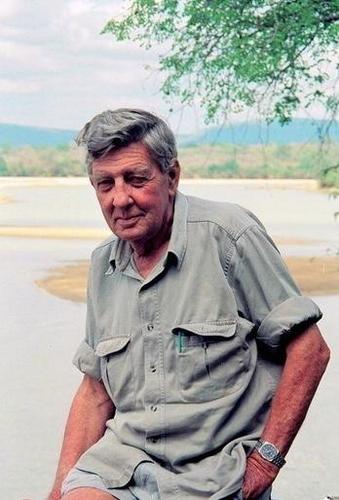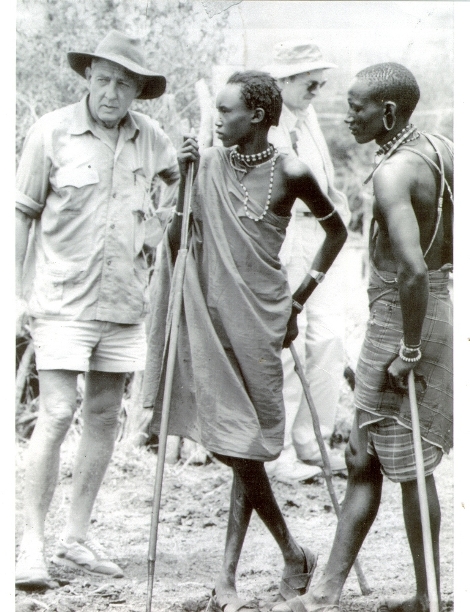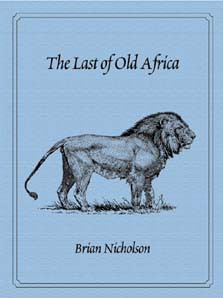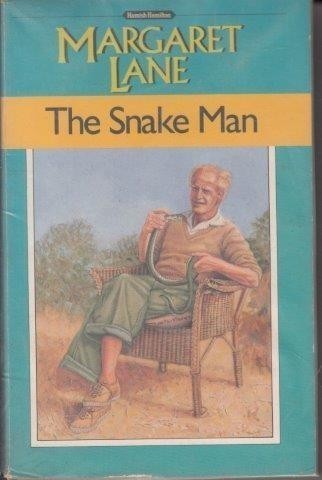J.P. Ionides & Brian Nicholson
Pioneers of conservation in Tanzania and the mighty Selous Game Reserve
J.P. Ionides & Brian Nicholson
Constantine John Philip Ionides (1901 - 1969) was a former British Army officer turned ivory hunter and later Game Warden. Considered a great hunter, precocious conservationist and a celebrated naturalist he continued his avid hunting, and collecting of rare species from as far away as Sudan and Abyssinia. a great hunter, conservationist and a celebrated naturalist and known as the 'Father of the Selous' by none other than Brian Nicholson, as he designed the Selous Game Reserve as a highly controlled hunting reserve. He was recognised as a world-renowned herpetologist and collected thousands of deadly snakes, especially green and black mambas, puff adders and cobras.
Brian Darnley Nicholson, was a true legend of East Africa. Renowned warden of the Selous Game Reserve unitl 1973, he single-handedly expanded the reserve and is considered largely responsible for its success.
CJP IONIDES'S STORY
Several white hunters became famous wardens, and one of the most respected of these became the savior of the largest game reserve in the world, C. J. P. Ionides, whose Greek surname (pronounced eye-ou-eedees] belied a British upbringing. As a youth in England he had been enthralled when reading the hunting exploits of Frederick Courtney Selous. After army service in India, Ionides, known as Iodine in Africa, wangled a transfer to the 6th Battalion of the King's African Rifles. In 1926 he was posted to the British administrative capital of Dar es Salaam, Tanganyika. At the time Dar es Salaam was a small, humid seaport boasting a British club, a couple of hotels, the best of which was the New Africa, along with half a dozen shady bars. Seeing no future in peacetime soldiering, Iodine resigned from the army to become a fulltime ivory hunter.
At Dar Iodine ran into a white hunter named Ken McDougall, who talked Iodine into becoming a professional white hunter. Iodine writes: I was immediately attracted by his diabolically criminal-looking face. He was drunk and had embarked upon a diatribe directed against his erstwhile trusted house servant, who apparently had deserted him the night before. McDougall's favorite African mistress was due to produce what he believed was his child. The baby arrived and McDougall had taken one look at it to realize why the trusted servant had left in such a hurry.
Aware McDougall was a hopeless drunk, Ionides still went into partnership with him in a safari venture based at the up-country town of Arusha, in the belief that outside of towns McDougall "was a very fine hunter, besides being a good naturalist." But booze also made McDougall fighting drunk, a trait that hardly sat well with safari clients. Inevitably the partnership ended.Iodine’s old army friend, Jock Minnery, had became game ranger at Arusha, and another of his friends, Monty Moore, was warden of the Serengeti. Iodine badly wanted to join the Game Department, something that was not easy to do in those days. "Coming from an admitted poacher," Iodine wrote, "this may sound like an American gangster saying that what he really wanted to do was be a cop. But I had primarily gone into professional poaching to gain experience in hunting as well as to be able to survive as a hunter. Having learnt all the tricks I would be invaluable to the department, as indefatigable in the pursuit of poachers as I had been in the pursuit of poaching. Only a slight mental readjustment was required, of outlook and intention."
With the help of his friends Ionides became an assistant game ranger in 1933, beginning with the slim salary of £40 per month. During the 1930s the Tanganyika Game Department had just six European game rangers headed by chief game warden Philip Teare, and 120 African game scouts. This tiny staff was supposed to control all matters concerning wild game in Tanganyika Territory, which consisted of 362,688 square miles. As a new recruit Ionides was sent to Kilwa, a small but ancient coastal port 180 miles south of Dar es Salaam.
Courtesy: An extract from White Hunters: The golden age of African Safaris by Brian Herne 1965
History Behind The Establishment of Selous Game Reserve
• Before an official establishment of the region currently named Selous Game Reserve, the area was a vast ecosystem that had the burden of being a slave and ivory route from the interior regions of Tanganyika all the way to the coastal region of Kilwa.
• In 1896, the German Governor stopped hunting in an area north of the Rufiji River and officially declared it a Game Reserve making Selous' region the first protected area in Africa. Further areas to the west and east of the already protected area were officially declared as German controlled Game Reserves. • In the years later, efforts were made by the German Government and George Schillings to enact Wildlife Conservation Laws and develop sustainable wildlife conservation policies. • After the British Empire declared Tanzania, then called Tanganyika, a protectorate, it expanded the already existing German Game Reserves to more areas, and in 1922 it officially named the region "Selous Game Reserve." • In the 1930 and 1940's, the British Protectorate moved natives of the region who were affected by Nagana or Sleeping Sickness, outside the tse-tse fly affected areas and declared those empty areas part of the Game Reserve. • Because Selous was an area so blessed with large concentrations of wildlife, some of the animals like elephants would move into human habitats, which would end up posing a big problem. Constantine Ionides, Tanzania game officers and scouts participated in the control and protection of wildlife. • Brian Nicholson, Selous' last European Chief Warden proposed an idea to turn Selous into wildlife hunting block, which would bring in the necessary finances to keep up with the resources necessary to build an infrastructure and establish an anti-poaching team. • The Tanzanian Government imposed a hunting ban in the Selous, which put a stop to revenues coming into the region from professional hunters who were paying tens and thousands of dollars. Thus, the whole region suffered terribly during this period. • Around 1975, efforts to boost energy supplies in Tanzania led to the development of a dam and hydroelectric scheme, which recruited over 2000 workers to area which consequently led to poaching of the many rhinos that were resident to the Selous. • Further oil exploration in the early 1980's led to opening up of more paths that were previously inaccessible due to the pristine and dense vegetation, creating an easy entry and exit for wildlife poachers. • In 1982, the Selous Game Reserve was granted "World Heritage Site" status, which formally put it on the map. • From early 1980's to early 1990's poaching continued to intolerable numbers. The Selous elephant population decreased from 110,000 to below 30,000 but world attention the Selous Game Reserve had received created an awareness among young wardens, Tanzanian Government and its wildlife sector, and international organizations like Frankfurt Zoological Society, who worked on constructive policies that focused on restoring Selous' reputation of being home to one of the greatest numbers of wildlife and being untouched by man's deliberate activities.Go back to: Pioneers in conservation
BRIAN NICHOLSON'S STORY
An uncontested member of the Great White Hunter club, Nicholson began his career as a game officer at the age of 19. He was famed for long walking safaris deep into the Selous, often following its river systems miles into the wilderness. In fact, in 1979, it was Nicholson who instilled the passion for walking safaris in a young Richard Bonham, one of the founders of Sand Rivers Selous and Nomad Tanzania. That expedition was immortalized by Peter Matthiessen in his book, Sand Rivers, which gave Richard's lodge its name. It is in the spirit of that expedition that Nomad continues to do multiday walking safaris - Nomad Safaris
Brian Nicholson was responsible for the vast Selous Game Reserve and all the great southern ranges in Tanganyika. He was eventually responsible for about 100,000 square miles of roadless country where foot safaris were the norm. When he first moved in, it was a fourteen-day journey to his base camp. Transport started with the railway, followed by the bus and then a DC-3 flight; the last five days were on foot. Over the years he was to journey more miles on foot than by any other form of transport.
The Selous Game Reserve was nearly doubled by his legendary predecessor “Iodine” Ionides, and later by Brian Nicholson between 1951 and 1973, to a total of 22,000 square miles. It is difficult to visualize such a large area—imagine a square 150 miles long on each side. They created forty-seven separate concession hunting areas, which profoundly changed the hunting safari business in East Africa. All of those who have hunted there owe these two men a great debt of gratitude.Courtesy: Anthony Dyer in his foreword to The Last of Old Africa by Brian Nicholson
Safari Hunting in East Africa was forever changed by the masterly blueprint of Brian Nicholson, a former white hunter turned game warden. The disciple and successor of C.I. P. Ionides, the "Father of the Selous game reserve," Nicholson conceived a plan for administering Tanzania's expansive wildlife regions. In 1965 he changed most of the vast former controlled Hunting areas, or CHAs, into Hunting concessions that could be leased by outfitters from the government for two or more years at a time. Nicholson also demarcated the Selous game reserve's 20,000 square miles of uninhabited country into 47 separate concessions. Concessions were given a limited quota of each game species, and outfitters were expected to utilize quotas as fully as possible, but not exceed them.
Nicholson's plan gave outfitters exclusive rights over Hunting lands, providing powerful incentives for concession holders to police their areas, develop tracks, airfields, and camps, and, most importantly, preserve the wild game. When the system was put into effect, it was the larger outfitting organizations - safari outfitters who could muster the resources to bid and who had a clientele sufficient to fulfill the trophy quotas Nicholson had set (done in order to provide government revenue by way of fees for anti-poaching operations, development, and research) - that moved quickly to buy up the leases on the most desirable blocks of land. Smaller safari companies who could not compete on their own banded together and formed alliances so that they, too, could obtain Hunting territories.Courtesy: An extract from White Hunters: The golden age of African Safaris by Brian Herne 1965
ARTICLES OF INTEREST
Brian Nicholson, One of the Fathers of the Selous Game Reserve by Rolf D. Baldus (Obituary)
PUBLICATIONS
A Hunter's Story by C J P Ionides - 1965 (published in the US with the title 'Mambas And Man-Eaters')
The Last of Old Africa by Brian Nicholson 2001 - ISBN 978-1-57157-454-1 (PDF)
Go back to: Pioneers in conservation



